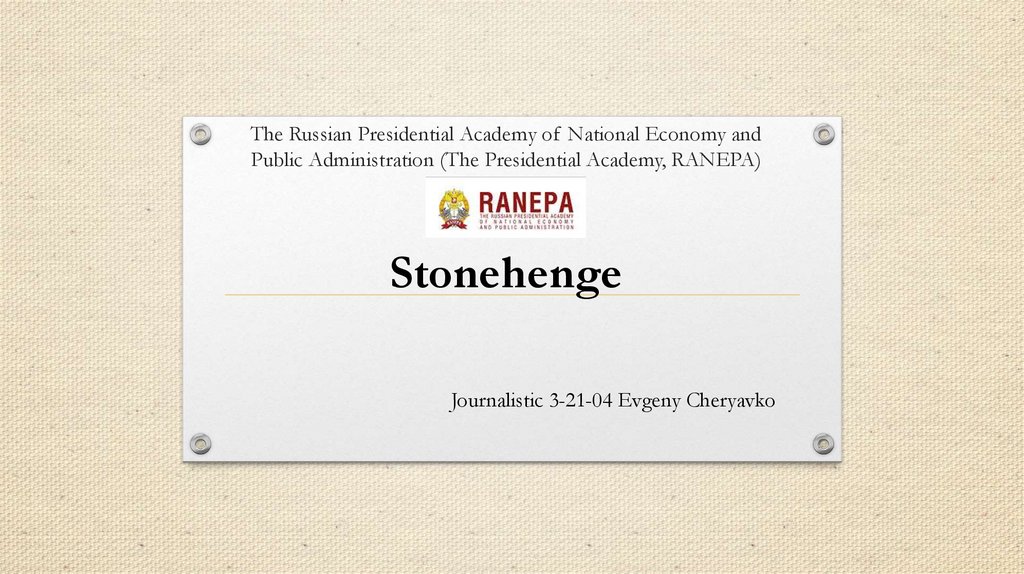Similar presentations:
Stonehenge
1.
The Russian Presidential Academy of National Economy andPublic Administration (The Presidential Academy, RANEPA)
Stonehenge
Journalistic 3-21-04 Evgeny Cheryavko
2.
Introduction• I chose this place because the history of its origin is covered with mystery, and Stonehenge
itself is incredibly amazing.
• Stonehenge is one of the most famous and popular architectural monuments of Great
Britain. It attracts all people, from tourists to modern druids, esotericists.
3.
4.
The history of this place• The object that we see today was not built in one day. In fact, the whole process consisted
of several stages and took almost 2000 years. It started back in 3100 BC, when there were
graves inside the ring of earth.
• The first ring was made around 3000 BC and was completely wooden. Only 4000 years later,
the builders began to fully use the stone. Most of the work falls on the period from 2640 to
2480 BC.
• The first stone ring was made of "blue stones" - Bluestones. 80 stones measuring 9 meters
and weighing 25 tons were delivered from Wales. To this day, we do not know exactly how
the stones were transported.
• The following rings were made in 2400 BC and are the largest and heaviest in the entire
structure.
5.
6.
7.
Creation Legends1) There are several legends about the builders of Stonehenge. According to one of them,
the legendary sorcerer Merlin created an amazing structure overnight. Thus the magician
paid homage to the king of the Britons, who had won a victory over the Saxons.
2) The second myth says that the concentric stone circles are the result of the devil's
mischief. In an old English fairy tale it is written that he bought some stones from an Irish
widow and played with them on the plain.
8.
Interesting facts about StonehengeThe construction of Stonehenge lasted 1500 years
The first written mention of Stonehenge dates back to the 12th century
Visitors are not allowed to climb the rocks
An ordinary British citizen owned Stonehenge for three years (Stonehenge was the legal
property of the British state for most of the last century, but would never have fallen into
the hands of the government if not for the charity of Cecil Chubb. In 1915, a millionaire
bought his wife Stonehenge as a gift for £ 6,600. His wife, however, did not like the gift and
three years later Chubb presented Stonehenge to the state on the condition that the
monument would be maintained unchanged and would be open to visitors.)
9.
ConclusionThere are suggestions that Stonehenge was used as:
• An object of worship of the gods
• A place for conducting various rituals
• A structure for determining the position of the stars, and observing certain traditions
• A place of ancestor worship, honoring the memory of a dolmen of power, designed to
obtain energy or power









 culturology
culturology








